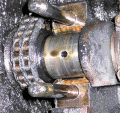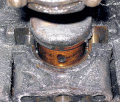
Big End Failure
The engine appeared to be running well, but a niggling feeling was present that the oil pressure readings didn't make sense - they remained at around 30psi hot or cold and even at tickover. Symptoms pointed to a blocked oil pipe somewhere.
September 2005:

Off with the sump again! There appeared to be plenty of oil around the bearings - but was it enough?

There was little if any play in the big-ends but I had to find out if I had a blockage in the oilways.

Checking the white-metal big-end bearings showed that 7 of the 8 white metal bearing "shells" were very badly fatigued.

These are just two; one about to break up, the other has already done so - and these weren't the worst ones!

Here they are - ouch! This is #1
Notice that at least one part of the bearing surface is still present all the way around, so no big-end play was detected and oil pressure appeared OK (in fact rather higher than expected, which led to the investigation in the first place!)

. . . . and all four con-rods before sending off for re-metalling to C K Motor Engineers of High Wycombe, who proved most helpful and informative.

It wouldn't drop out easily so I used an impact puller - amazingly, the thread fitted otherwise I should have needed to make up an adaptor.

Same with the front main bearing - when the lower cap is removed, the crank is suspended from the timing chain.

The rear main cap wouldn't drop out as it fouled on the back of the engine block. Don't believe all you read in books!

It looked like the shell should drop and pass between the cap and the crankcase - but it just wouldn't drop which meant that I had to remove the rear cap completely. The only way of doing this was to remove the studs and they eventually came out after a lot of muttering from me!

The cap then dropped away, but although I could move it, the shell wouldn't come out as it fouled on the rear crankcase bolts.
But at least it allowed a little clearance so I could push the pipe cleaners through and spray cleaner in to make certain the bearing and oilways were clean.

Also had a bit of problem with the worn out starter handle nut on the front of the crankshaft. I used a big spanner, stillsons and extension levers - together with a soaking in Plus Gas of course. I bent extension levers.
Eventually it gave way to heating with a small gas torch, an original Austin full ring spanner and a 4lb hammer! I was amazed at the strength of the original thin Austin spanner - the one that came with the toolkit for the front wheel grease caps. It withstood many hefty hammer blows before the nut decided to loosen.

Once off, it was a simple matter to screw on the new one - NOT! The new nut had surface rust on the threads - Admiralty 20tpi threads - not exactly available any more! So there was no possibility of running a tap down the threads.
It took some while to chase the threads out by hand with another 20tpi tap but eventually it went back on. Good job I'm not paid by the hour - it took about three days on & off to get the starter nut off and the new one on!
and up to June 2011 - I've never had to use the new starter dog in anger as the engine always starts "on the button" even after being outside and unused for a month in the coldest of weathers.
January 2006:
After (slowly) acquiring the parts, the rebuild continued with the reassembly of the pistons and con-rods, oil pipes and oil pump









